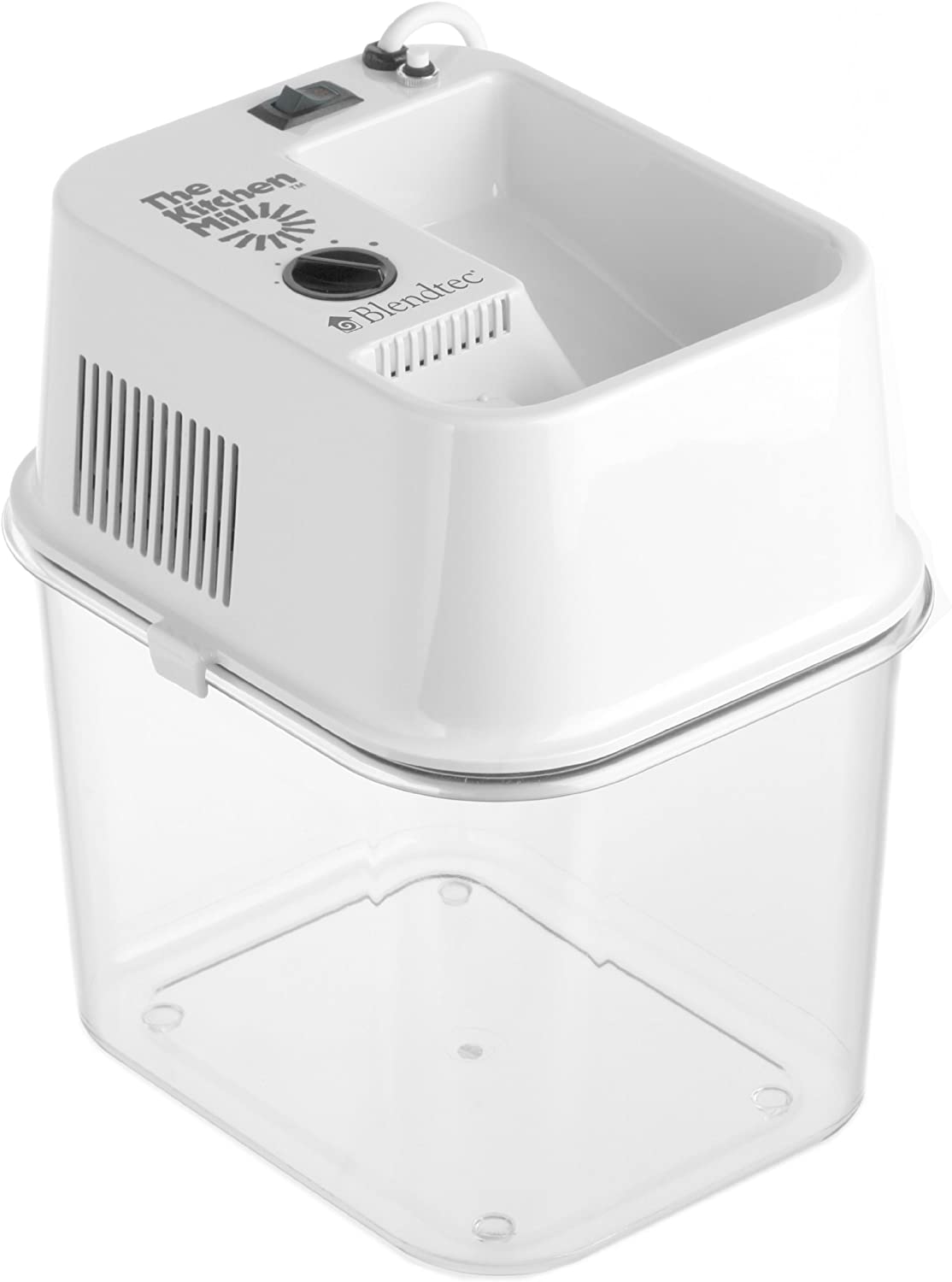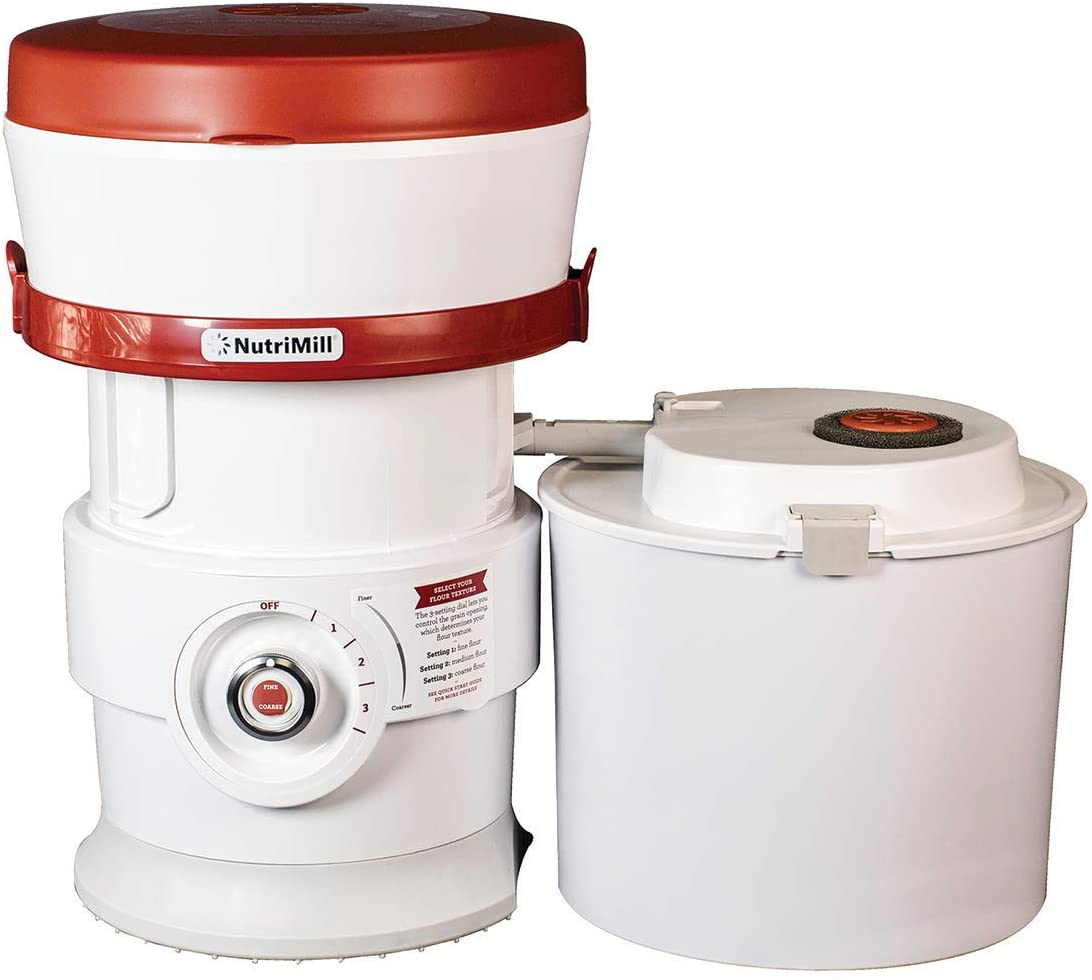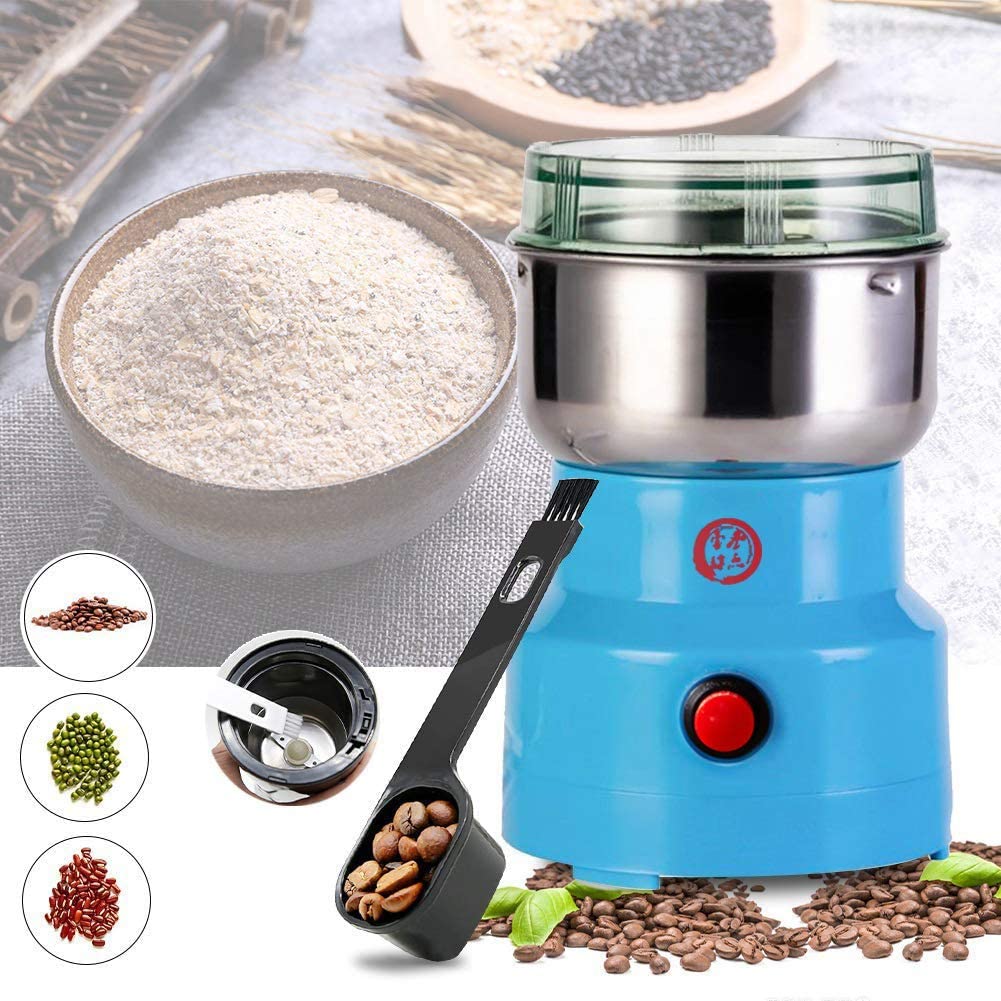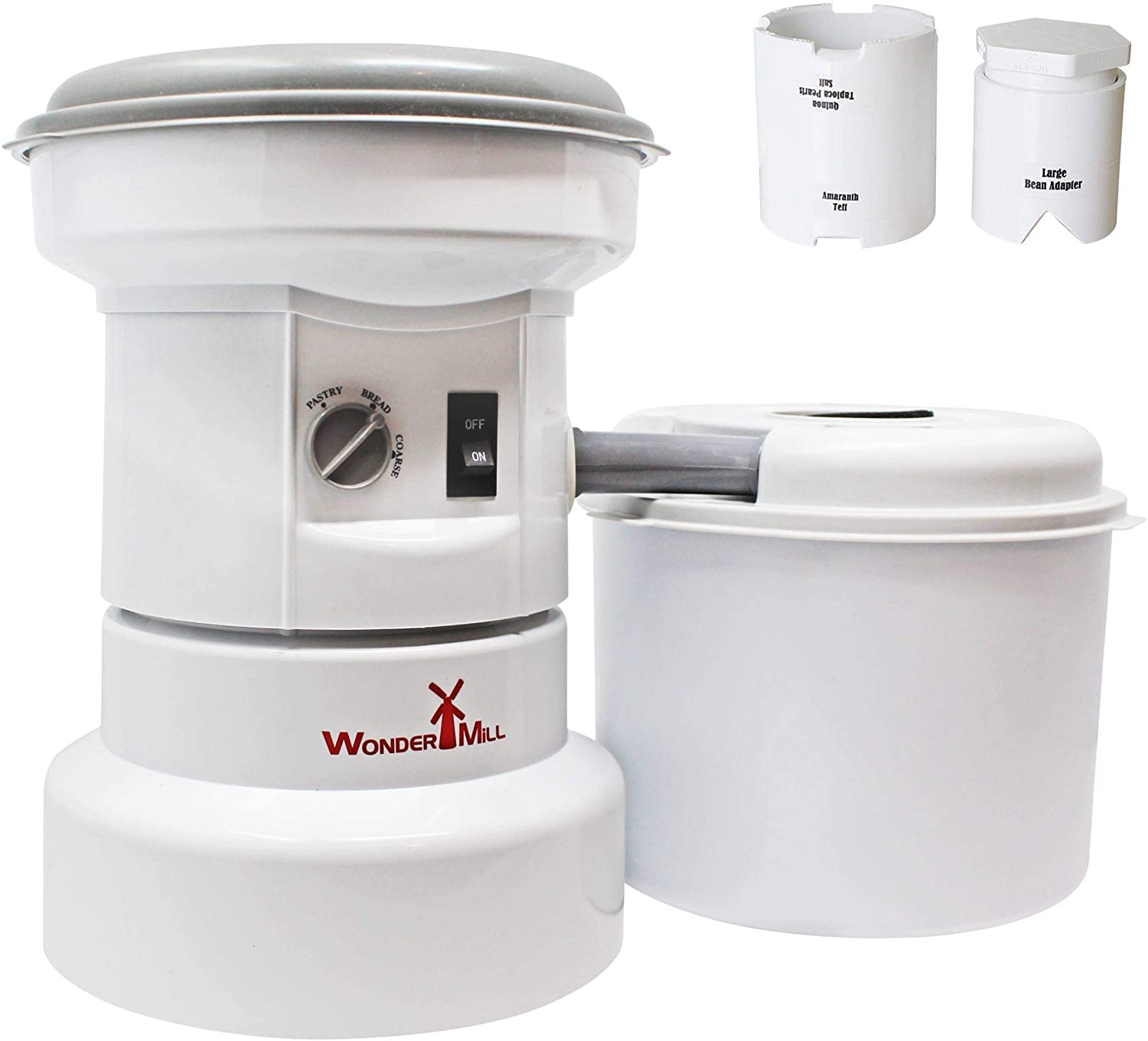Best Grain Mill
Back in the day, turning grains into flour at home to make bread and other baked goods took hours of grinding by hand. With modernization and technology, large grinding mills did the job quickly and efficiently and grain-based flours became easily available at the supermarket. These days, the trend is shifting back into the home with people wanting to grind their own flour using a good grain mill.
A good grain mill lets you customize the grind and have access to a super fresh product for fresh, homemade bread. It also should be versatile enough to grind other things like spices, beans, nuts, coffee beans and seeds. These convenient machines have been a boon for people with sensitivities to the gluten found in wheat products. With a grain mill, they can experiment with different flour mixes to create delicious gluten-free bread, cookies and cakes.
We feature five grain mills you can purchase online. Read on to find one that best suits your needs.
Top Pick Best Manual: Victoria Cast Iron Grain Mill
These days, you’re into making authentic corn tortillas and whole-wheat bread. But instead of buying flour at the grocery store, you want the freshness of grinding your own grains. Plus, your summer cottage is not near a town, so you want the freedom to access milled grains whenever you want.
For an easy to use grain mill that doesn’t need an electric source to work, we recommend this manual model from Victoria. Made of durable cast iron, this grain mill has sanitary double-tin plating that resists stains and corrosion, and is compliant with international regulations. The high-performance discs are made from anti-erosion white iron for maximum durability and performance with all types of grains, so you don’t have to worry about the end result.
The mill’s high hopper has a large capacity and by manipulating the adjustable screw, you can adjust for a fine or a course grain to obtain the texture you need. So versatile, this mill can be used for home brewing, corn, barley, grains, coffee, cheese, vegetables, seeds, nuts, coconut, spices, dried beans and even cooked meats.
Take it anywhere you need to go. The clamp is easily adjustable to most tables and boards measuring ½-inch to 2 inches thick. It also has a protective non-slip rubber that protects your surfaces and prevents the grain mill from slipping when doing heavy work. And the grinding disk cover offers up an added level of safety and grind output control.
Pros:
- Affordable
- Made from sturdy, durable cast iron
- Can adjust the texture of the grind
- Versatile; grinds more than grains
- Portable, attaches to most tables
Cons:
- Manual
- Can be difficult to get a fine grind
Top Pick Best Versatile: Blendtec Kitchen Mill
For anyone who has a large family or perhaps a small home-based baking business, being able to mill grains quickly and efficiently is a no-brainer. For large batches, using a manual grain mill can mean hours of work that an electric model can cut in half.
If you are looking for an electric grain mill that can produce a large quantity of premium quality grind in minutes, then consider this one from Blendtec. This model incorporates a healthier way to mill grains. By using a surgical stainless steel micronetic milling chamber that ‘bursts’ the grains instead of grinding them, it produces the lowest starch damaged flour (for the loftiest bread) at the lowest temperature and the highest output in order to preserve nutrients.
There’s no waiting or wasting time with this grain mill – it can produce up to 24 cups of natural, whole-grain flour in less than six minutes. This is truly an efficient way to make flour from grains, soybeans, rice, beans, and legumes (including oily soybeans, high moisture rice, hard popcorn, etc.), and with the see-through transparent bin, it’s easy watch how the end product comes out.
Pros:
- Milling chamber never gums, jams, or glazes
- Can produce 24 cups of flour in less than six minutes
- See-through transparent bin
- Lightweight at 8 pounds
- Powerful 1,560 watt commercial-grade motor
- Made in the USA
Cons:
- Not easy to clean
- More expensive than manual models
Top Pick Best Self-Clean: NutriMill Plus Grain/Flour Mill Electric High Speed Grinder
You’re all about convenience, but not at the expense of functionality. All of your kitchen gadgets and small appliances need to make easy work of all your food prep tasks, but they have to also do it well. A grain mill is no exception. You want a machine that can handle large-batch grinding without leaving too much of a mess behind.
For a mill grinder designed for convenience and functionality, we recommend this model by NutriMill. The 24-cup bowl capacity on this grain mill has a collapsible hopper and a cute nesting design for easy storage. But it’s the grinding that really counts, right? Well, this model doesn’t disappoint.
The 1,200-watt, two-speed motor uses stainless steel microburst milling heads to quickly and easily grind all grains, legumes, corn and rice into fresh, nutritious flour. A texture-control switch makes it easy to choose between ultra-fine and course flour, and the grain feed design allows you to turn the unit off anytime during the milling process without damaging the motor or milling heads.
The patent-pending “whisper quiet” technology of this grain mill surrounds the micronizing chamber with a muffling barrier and sound insulation for a lower decibel, quieter milling experience. As well, the side-by-side design means the flour canister sits beside the mill when it’s being operated, allowing you to mill directly in the canister.
Finally, when it comes to cleaning, this machine makes it easy with its patent pending filtration system that uses a dual cyclo cup, canister chamber, and diffusing filter for a cleaner milling experience. It doesn’t get much better than that.
Pros:
- Whisper quiet technology
- Self-cleaning canister
- 1,200-watt, two-speed motor
- Collapsible hopper for easy storage
- Control switch to choose between ultra-fine and coarse flour
Cons:
- There can be issues with the ultra-fine setting
- More expensive than manual models
Top Pick Best Basic: YUESUO Multifunction Smash Machine
You’re on a budget and want to be able to make your own flour from grains and nuts, as well as grind fresh coffee beans, whole peppercorns and other spices. Most electric grain mills are out of your price range, and you’re not into a manual model.
If you are looking for an affordable electric grain mill that won’t burn a hole in your pocket but will do the job right, then consider this cute compact model. This machine uses a high powered, serrated four-blade rotary cutting process to quickly crush rice, corn, soybeans, dried chilies, peanuts, red beans, coffee and more.
The grinding chute and blades are made of food-grade stainless steel for a fast and even grind. Simple to operate, just press the on/off button to start grinding and release to stop. The transparent cover allows you to observe the grinding process, and you have the option of choosing a coarse or fine powder.
Easy to clean, easy to use, compact and lightweight, this mighty machine just may end up being one of your favorite and most versatile kitchen tools in your arsenal.
Pros:
- Affordable
- Grinds a variety of foods from grains and legumes to coffee beans, nuts, seed, spices and more
- Compact and lightweight (weighs 1.1 pounds)
- Easy to operate
- Built-in overheat power-off protection switch
Cons:
- Small capacity; grinds 50 mg at a time
Check Price
Top Pick Best Overall: WonderMill Grain Mill Grinder with Flour Canister
You’re totally gluten-free and prefer to make your own flour for your cooking and baking needs. With all the experimenting you do, you’re looking for a grain mill that is so versatile, it can handle any size or texture of bean, legume, grain, spice – whatever you need to be done.
To meet all of those specific needs, we recommend this model from WonderMill. Strong and efficient, the 1,250-watt LG motor can grind almost anything — from wheat, rice and corn to gluten-free grains, legumes and beans. It is designed to mill super-fine flour like pastry flour or tapioca flour to coarse semolina flour at temperatures that preserve the nutrients within every grain.
There are no small parts or gaskets to misplace, and the machine is quiet and virtually dust-free. Simple to operate, just set the texture knob, turn on the mill, fill the hopper and grind away. But what makes this grain mill stand apart are the two attachments specially designed to grind small and large beans.
The Small Grains Adapter has two settings: one end has deeper notches for amaranth, tapioca, quinoa, teff and other very small grains and spice seeds while the other end is for rock salt and slightly larger grains. Simply choose a side and grind dry seeds and grains.
The Bean Adapter is designed for larger beans or seeds like garbanzo beans (chickpeas), which are difficult to mill due to their unique shape and texture. This adapter solves this problem; it allows large beans to feed into the hopper slowly without clogging the mill.
This grain mill is built to grind flour in minutes and complies with the world’s most demanding electronic-testing and certification standards: – UL (for the USA), CSA (for Canada), and CE (for the EU).
Pros:
- 1,250-watt LG motor
- Includes small grain and bean adapter attachments
- Grinds large quantities in minutes
- Simple to operate
Cons:
- More expensive than other electric models
- Not recommended for grinding oily grains, nuts, and seeds
Things to look out for:
Consider these things when looking for a grain mill so you will choose one that works best for you:
Manual versus electric:
Whether you choose a manual grain mill over an electric model is a personal choice, but each one has its benefits and drawbacks. Most, but not all, manual models have a broader price point with more to choose from in the lower-end, more affordable range. They are more portable than electric models and do not rely on electricity to operate, so they are good for camping, the cottage or the boat. The downside is that they take a certain amount of strength and dexterity to operate. Anyone with arthritic hands, or trouble gripping, may find using a manually operated grain mill a challenge. These models also need to be attached to a table or bench with a specific thickness to properly adhere to and withstand the force of grinding.
On the other side of the coin are electric grain mills. These can be affordable, but the larger capacity models are often on the higher end of the price range. That being said, for the most part, they are very easy to use. Just plug them in, press a switch, and the work gets done in minutes. The capacity of an electric model is often larger than its manual counterpart. Electric models are also often bulkier and heavier, but compact, lightweight versions can be found.
Use:
Once you have decided between a manual and electric model, think about what you want to use the grain mill for. If you don’t use a huge variety of grains, then most models will do. If you are gluten free and like to experiment with different sized grains, nuts and seeds and you also want to grind coffee beans and spices, make sure the model you purchase is able to handle these different tasks. Finally, choose a model that grinds to the fineness or coarseness level that you need to make the flour that works best for your cooking and baking needs.





